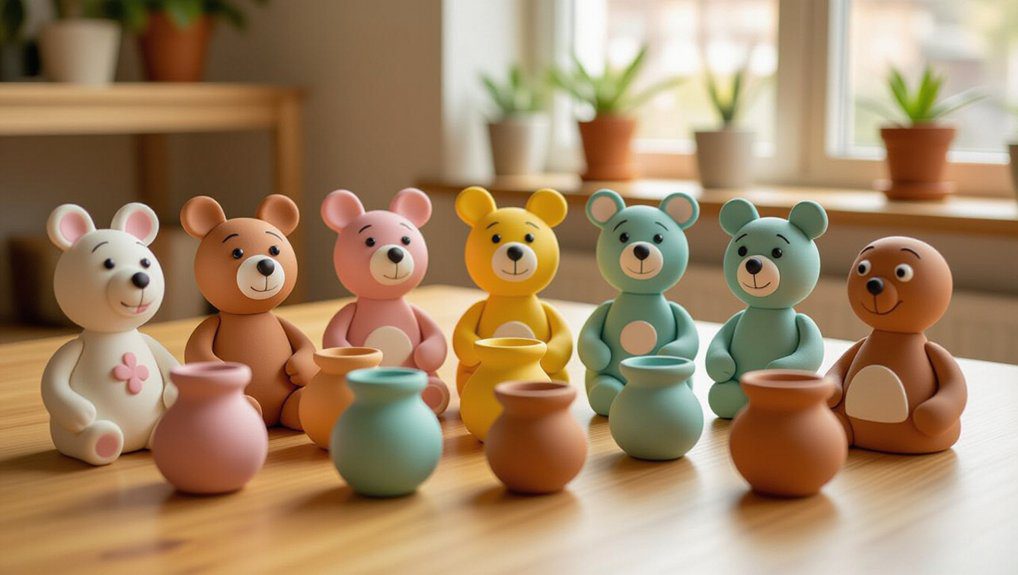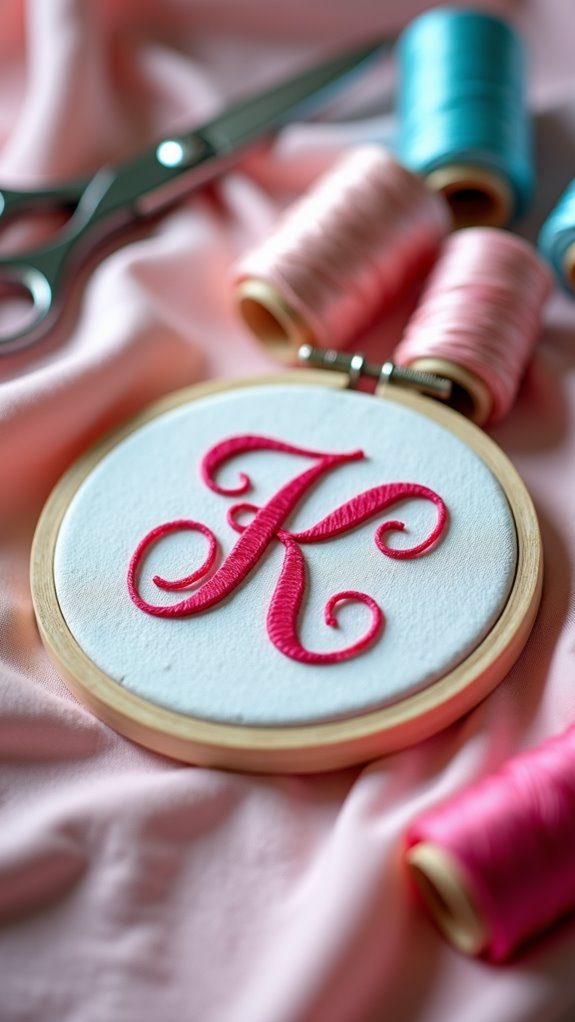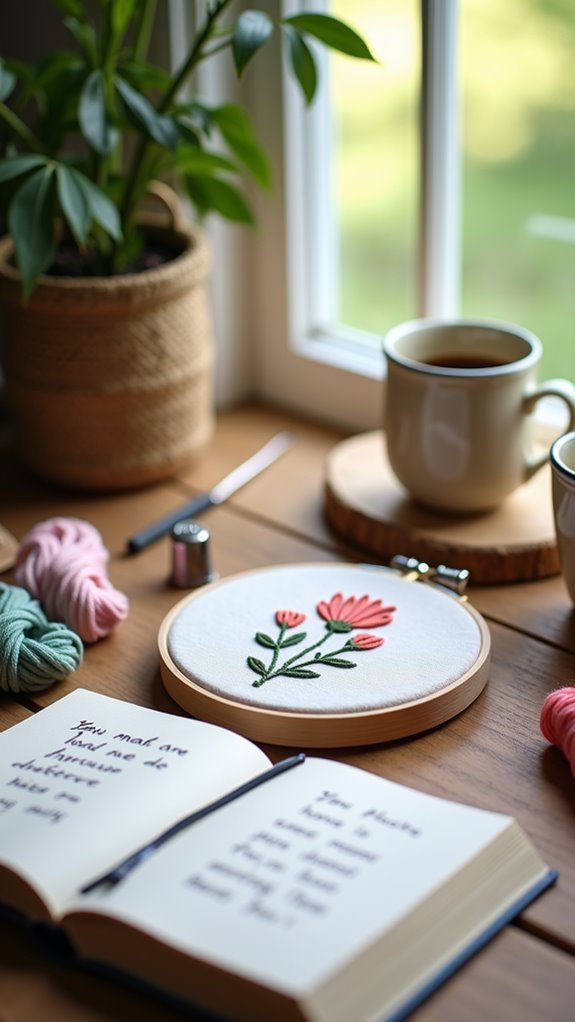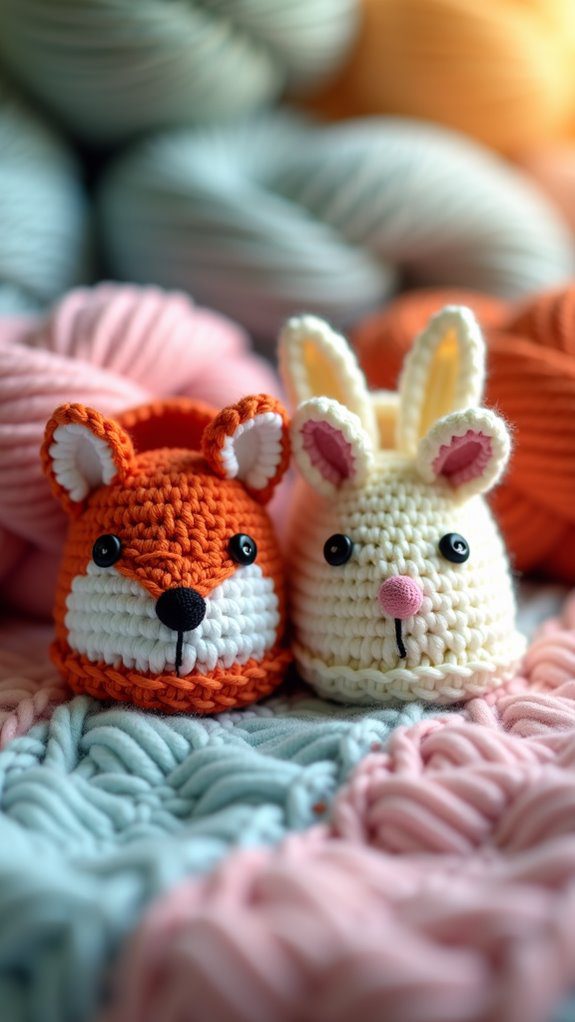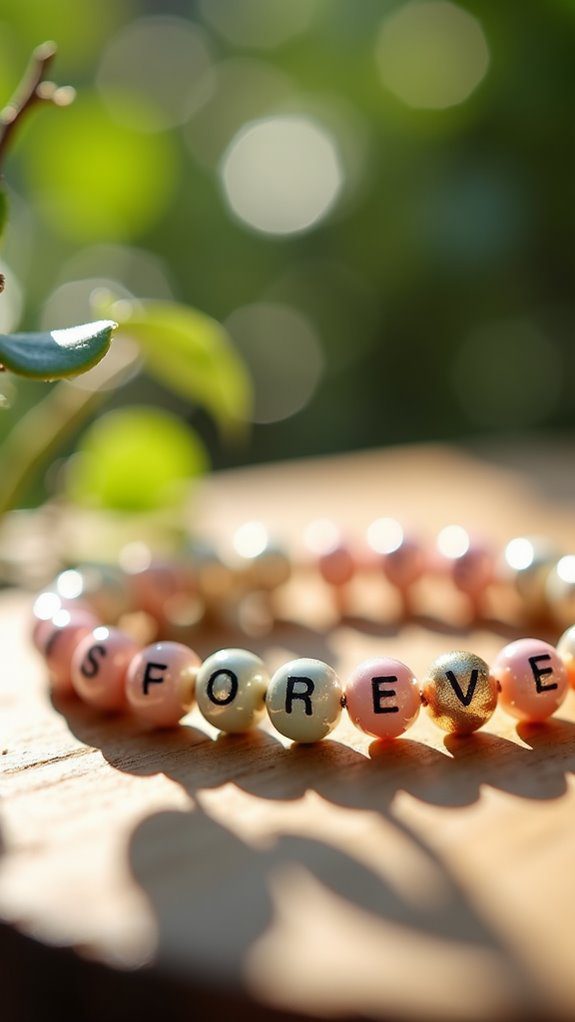If you’re new to clay sculpting, start with simple shapes like spheres and cubes to get comfortable. Try pinching clay balls to make bowls or pots—it’s easy and fun! Making caterpillar sculptures from colorful balls helps build your skills and adds charm. You can also create jewelry like clay earrings or tiny flowers for miniature gardens. Adding textures or painting your pieces opens up lots of creative paths. Keep experimenting, and you’ll soon uncover more exciting ideas!
Key Takeaways
- Start with simple geometric shapes like cubes and spheres to build foundational sculpting skills and confidence using air-dry clay.
- Create fun sculptures such as colorful caterpillars using small clay balls and add whimsical details like antennae or googly eyes.
- Use the beginner pinching technique to form bowls or pots, experimenting with textures and patterns for hands-on learning.
- Make easy decorative projects like polymer clay earrings or miniature gardens, incorporating painting and functional elements before drying.
- Explore basic advanced techniques like coiling and slab building to construct larger vases or relief sculptures, enhancing creativity and form variety.
Simple Geometric Shapes Clay Sculpture Start Here
Although starting with complex sculptures might seem exciting, I find that beginning with simple geometric shapes is the best way to get comfortable with clay. Shapes like cubes, spheres, and cones are easy to create by rolling and shaping clay. Practicing geometric stacking and clay combinations lets you build fun structures without feeling overwhelmed. This approach helps develop your hand-eye coordination and boosts confidence. Using air-dry clay means no kiln is needed, so you can paint your creations once dry. Trust me, starting simple builds a solid foundation for your creative path together with others who share your passion.
Beginner Pinching Technique Creating Bowls and Pots

When you’re ready to move beyond simple forms, the beginner pinching technique offers a wonderfully hands-on way to create bowls and pots that feel both personal and satisfying. Start by rolling clay into a ball, then press your thumb into its center and gently pinch the edges, using consistent pressure for even thickness. Exploring pinch variations lets you add unique textures or patterns with tools or natural items like leaves, making each piece truly yours. Once formed, let your bowl or pot dry fully before firing or air-drying — a perfect introduction to fundamental clay techniques we all can enjoy.
Caterpillar Sculptures Cute Clay Creatures Easy
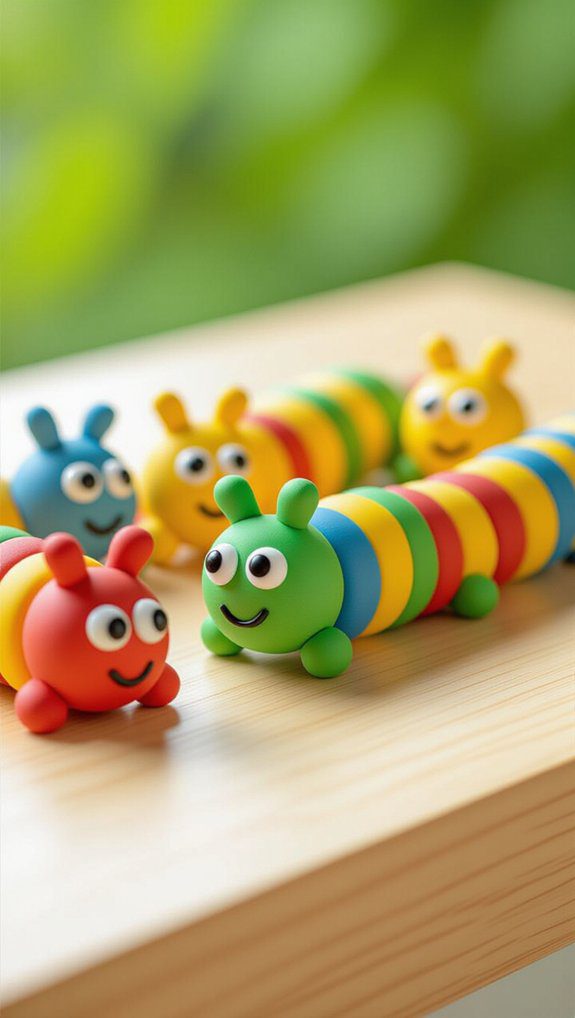
Anyone can have fun making caterpillar sculptures out of clay, and I promise it’s easier than it looks. Start by rolling small clay balls in your favorite caterpillar colors, then connect them to form the body. This simple step helps build your confidence and motor skills. Next, add whimsical designs like antennae or textured patterns for a personal touch. Using polymer clay makes shaping these cute creatures super manageable, even for beginners. Don’t forget to pop on googly eyes—they bring your caterpillar to life! These charming little sculptures make perfect gifts or decorations, and you’ll love creating them together.
Clay Earrings Jewelry Making for Beginners
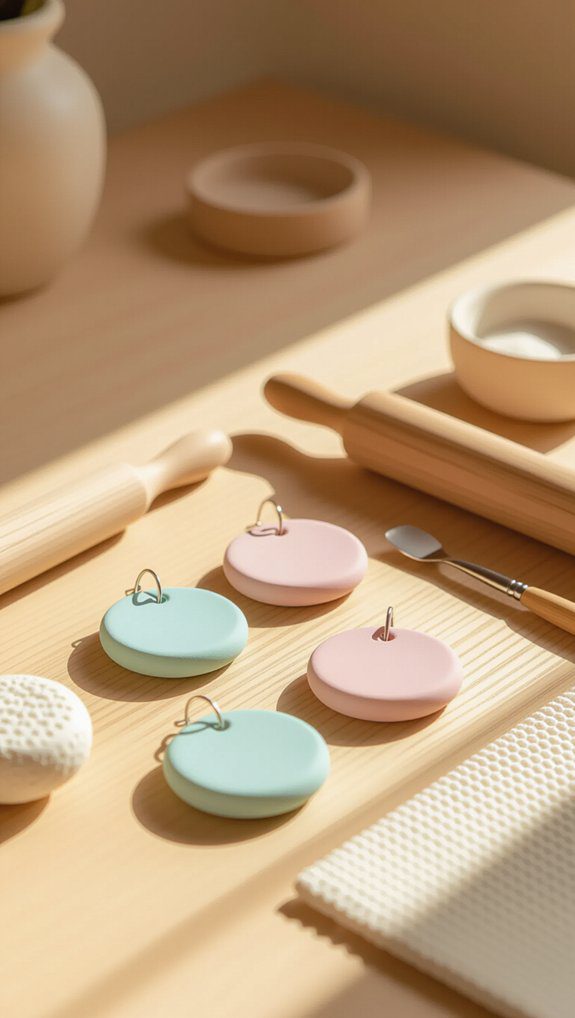
Clay earrings offer a fantastic way to dip your toes into jewelry making while having fun with shapes and colors. I love using polymer clay—it’s easy to shape and perfect for beginners. You can try simple geometric or floral designs, then paint them after drying for a personal touch. Staying on top of earring trends helps fuel design inspiration and keeps your creations fresh. Here’s a quick guide to get started:
| Step | Tips | Tools Needed |
|---|---|---|
| Shape & Sculpt | Use simple shapes to start | Polymer clay, sculpting tools |
| Add Hooks | Insert hooks before drying | Earring hooks |
| Paint & Finish | Paint dry earrings | Acrylic paints |
Let’s make jewelry that truly feels like you!
Clay Flowers and Plants Miniature Garden Ideas
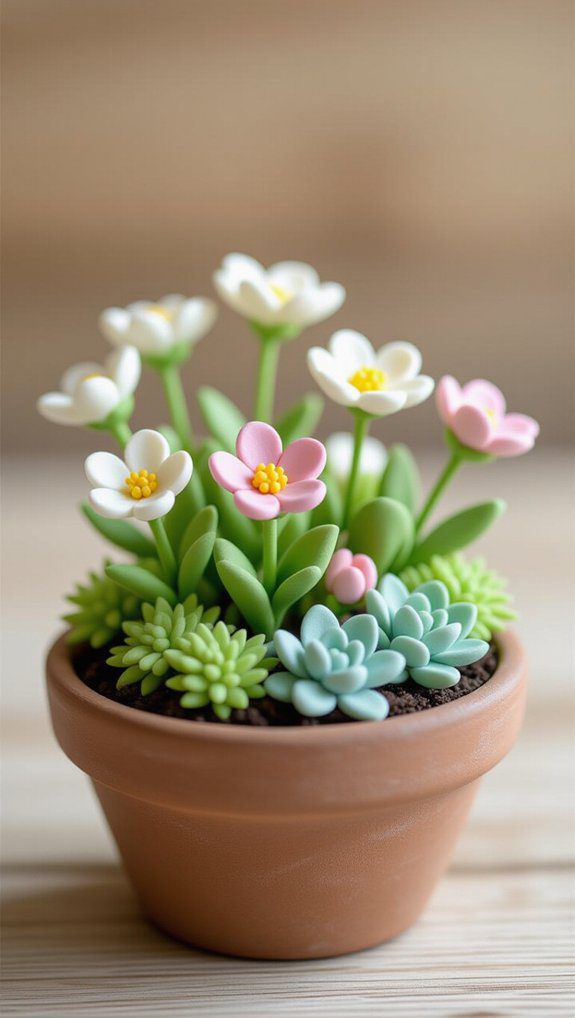
Although sculpting miniature gardens might seem tricky at first, I promise it’s a fun way to bring tiny blooms and greenery to life using polymer clay. Start by practicing simple clay techniques like rolling and shaping to create daisies, roses, or succulents. These small projects help you master texturing for realistic leaves and petals. Adding tiny pots or garden accessories really personalizes your miniature garden, making it feel like a cozy little world you built. Plus, you can customize colors and themes to match seasons or moods. It’s a creative adventure we can all enjoy together!
Animal Figurines Adorable Sculptures Step by Step

After bringing tiny flowers and plants to life, creating animal figurines is a wonderful next step that lets you add a bit more personality and charm to your clay creations. I start by gathering polymer clay in colors that match my cute creature inspirations. Using simple shapes like spheres and cylinders, I form the body and limbs, then enhance details with toothpicks or sculpting tools—these animal figurine techniques help add eyes, fur, or scales. Once I’m happy, I bake the piece according to instructions, making sure my adorable sculpture is durable and ready to join my growing collection.
Coiling Technique Building Vases and Large Forms
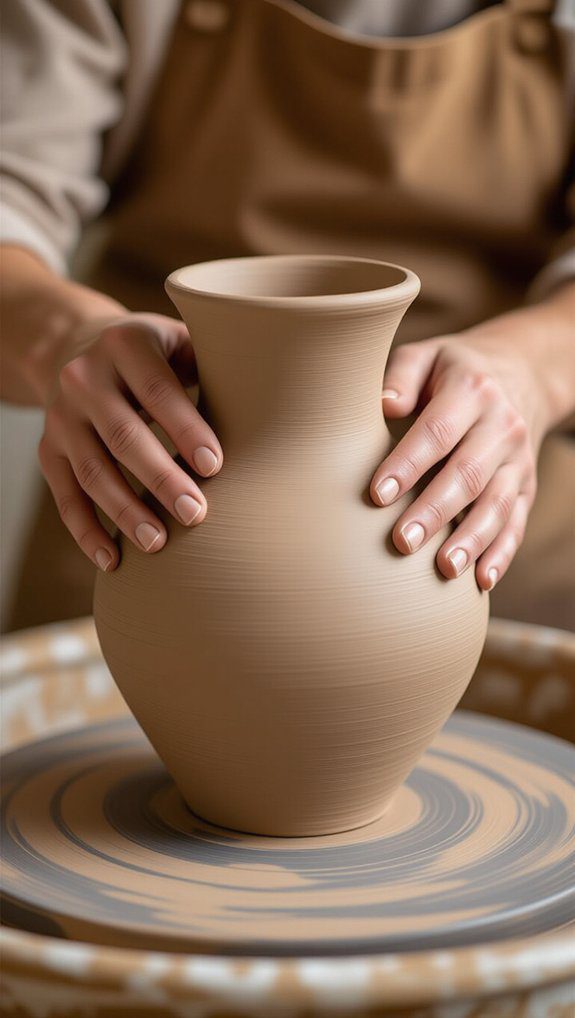
When you want to create bigger clay projects like vases or bowls, the coiling technique is a fantastic place to start. Coiling techniques let you build up walls by stacking long, snake-like clay rolls. Here’s how I approach vase designs:
- Roll even coils and stack them carefully.
- Blend and smooth each coil to keep the structure strong and seamless.
- Shape and texture your vase as you go for a personal touch.
This method really boosts confidence and creativity, making larger forms manageable without elaborate tools. Give it a try—you’ll love how your unique pieces come to life!
Clay Candle Holders Functional Decor Projects
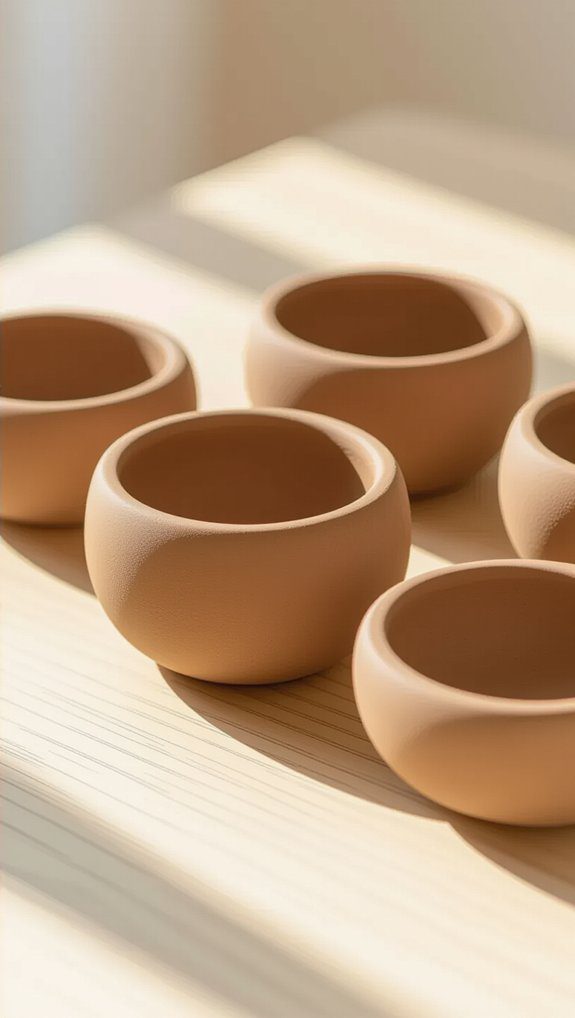
Building on the skills you practiced with coiling, creating clay candle holders is a fun next step that combines creativity with practicality. These pieces let you investigate creative design by shaping different sizes and adding textures or painted details. Using air-dry or polymer clay means no kiln is needed, making it easy to craft functional art right at home. Plus, each holder becomes a unique, handmade treasure—perfect for brightening your space or giving as heartfelt gifts. I love how this project grows your sculpting skills while creating something both beautiful and useful. It’s a wonderful way to belong in our creative community!
Relief Sculpture Flat and Simple Designs
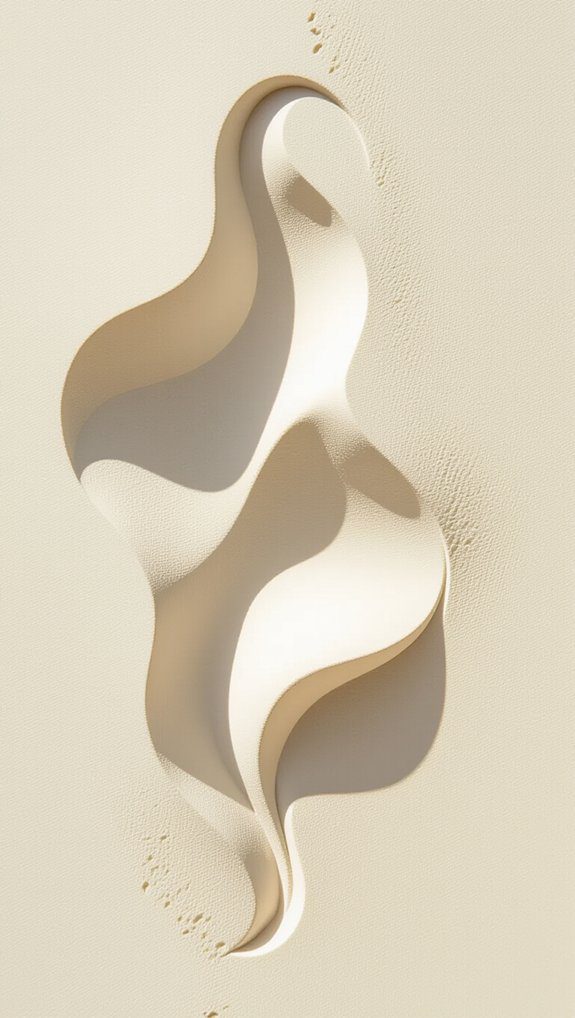
Although relief sculpture might sound complicated, it’s actually a fantastic way for beginners to immerse themselves in clay art because it starts with a flat surface and builds up simple shapes that really pop out. Using basic relief techniques, you can create eye-catching designs by:
- Starting with a flat slab of clay as your canvas.
- Adding or carving simple texture ideas like leaves or geometric shapes.
- Layering clay pieces to create depth without needing advanced skills.
This approach makes sculpting approachable, and together, we can investigate how fun and rewarding relief sculpture can be!
Slab Building Technique Square and Geometric Sculptures
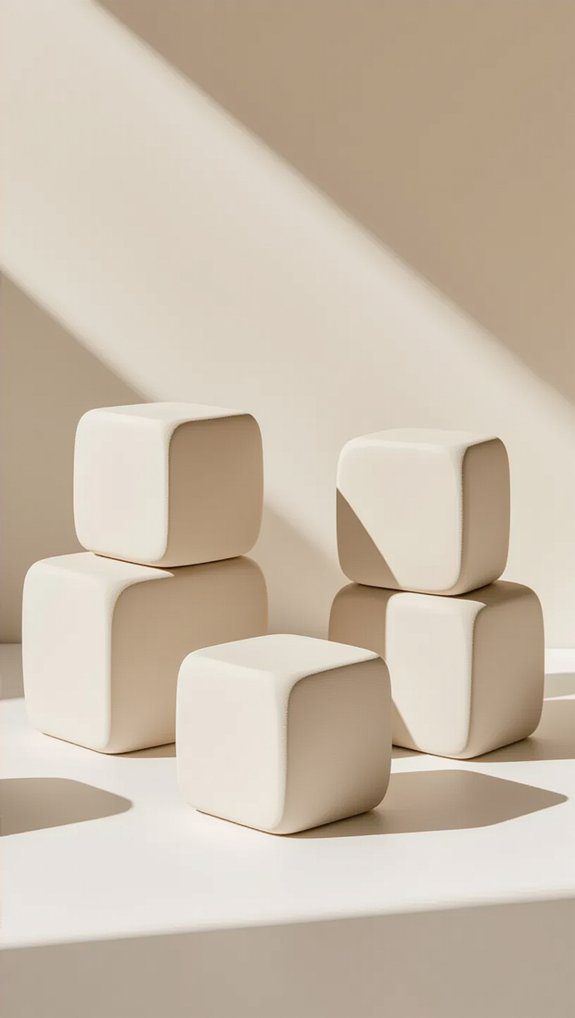
Since clay slabs offer a smooth, flat surface to work with, I find the slab building technique perfect for creating square and geometric sculptures that really stand out. Starting with slab technique basics, I roll out flat sheets and cut shapes like squares or rectangles. This lets me build sturdy forms—think boxes or tiles—that are great for geometric design investigation. Using tools like ribs and knives sharpens edges, making pieces look polished. Layering slabs and adding textures adds dimension, turning simple shapes into enchanting sculptures. Join me in trying this method; it’s a welcoming way to delve into geometry in clay!
Hand Modeling Without Wheel Easy Forms

One of the best things about hand modeling is how it lets you shape clay without needing a pottery wheel or elaborate equipment, making it perfect for beginners like you and me. With simple clay techniques, you can create charming forms by:
- Pinching the clay to form bowls or hearts.
- Rolling it into coils for bracelets or rings.
- Combining small shapes to craft animal figurines.
I love using polymer clay since it stays soft until baked, giving you time to tweak your work. These easy forms help build your skills and confidence while making art that feels truly yours.
Textured Clay Art Adding Patterns and Designs
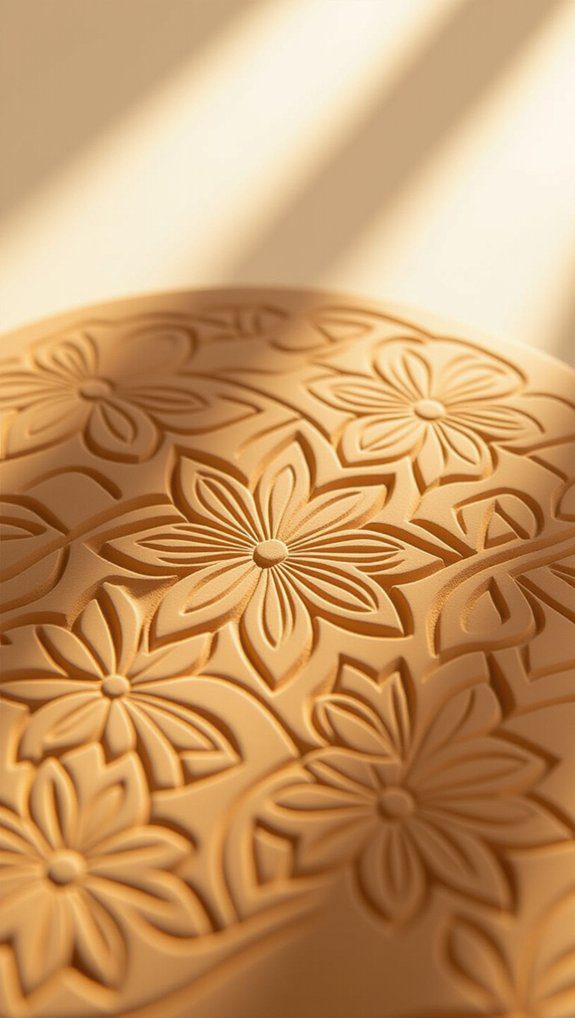
When you add texture to your clay art, you open up a whole new world of creative possibilities that can make your pieces truly stand out. I love using natural items like leaves or fabric for pattern inspiration. Creating textural contrast by mixing smooth and rough areas adds depth and excitement. Beginners can press objects or use fingers to craft unique designs, making each piece personal and inviting.
| Technique | Tools/Items Used |
|---|---|
| Stamping | Stamps, leaves |
| Rolling | Patterned rollers |
| Pressing & Grooves | Fingers, fabric |
Try these for a fun start!
Portrait Busts Introduction to Figure Sculpture

Shaping a portrait bust is a fantastic way to bring your clay skills to life by focusing on the human form. When sculpting, paying attention to portrait proportions and facial features helps make your bust realistic and expressive. Here’s how to start:
- Build a simple armature for support.
- Use polymer clay to seize fine details easily.
- Employ tools like sculpting knives and sponges to enhance textures.
This process teaches you about anatomy and balance, boosting your confidence and connecting you with a community of fellow sculptors exploring figure art together.
Abstract Clay Sculpture Modern Beginner Ideas

Although abstract clay sculpture might seem a bit mysterious at first, it’s actually a fantastic way to jump into sculpting without worrying about getting everything perfect. Abstract expression invites creative exploration through simple shapes and textures. Try rolling or twisting clay to form unique pieces that reflect your personal style. Here’s a quick guide to spark your creativity:
| Technique | Description |
|---|---|
| Rolling | Create smooth, elongated shapes |
| Twisting | Add lively, fluid movement |
| Texturing | Experiment with surfaces and feel |
These easy steps help beginners belong in the world of modern abstract art.
Painted Clay Projects Adding Color After Sculpting
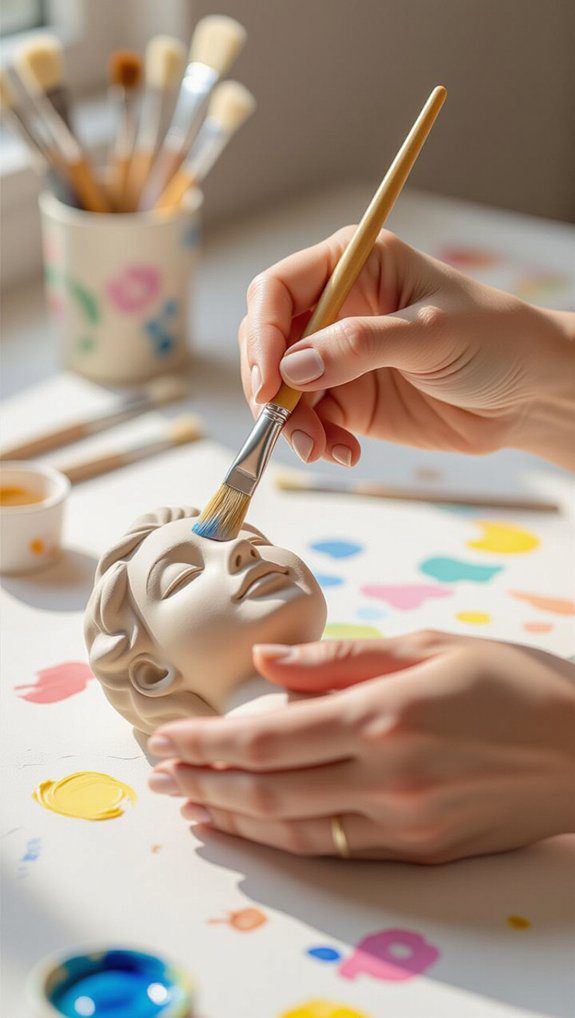
Since adding color can transform a simple clay sculpture into something truly eye-catching, I’m excited to share how painting your creations can bring out their personality. First, always let your clay dry fully before paint application to avoid smudges. Next, try these steps for vibrant results:
- Experiment with color mixing to find shades that feel right for your piece.
- Use acrylic paint for quick drying and easy layering.
- Seal your work with a clear varnish to protect and add shine.
These tips help us create colorful, unique sculptures that truly belong on display!


